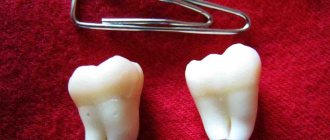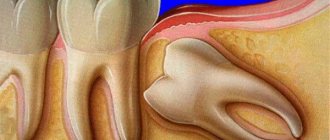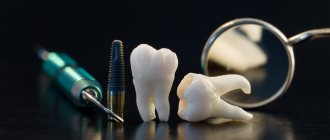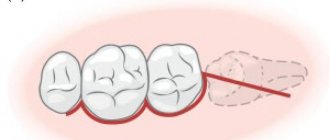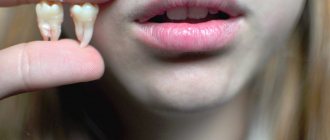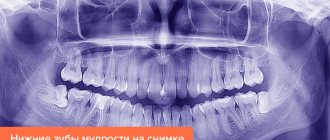Over the past few thousand years, the human jaw has narrowed by 10 centimeters. It turns out that the “eights” now do not have enough space, so their growth is accompanied by severe pain, swelling of the mucous membrane, inflammation and other problems.
The lower wisdom teeth usually hurt because the lower jaw bone is denser. The upper extreme molars erupt painlessly, but can rest against the cheek, injuring it.
Why does my gum hurt when my wisdom tooth grows?
Atypical growth
When the “figure eight” erupts, it is not the tooth itself that hurts, but the soft tissue surrounding it. This is a reaction to irritation of nerve endings. Most likely, the tooth grows at an angle and rests on the gum, which is why it responds with pain. Sometimes the outer molar lies horizontally and over time begins to injure the “neighbor”: it seems to you that your wisdom tooth hurts, but in fact it is a “seven”.
Pericoronitis
When teething becomes difficult, a gingival hood forms, covering the wisdom tooth. Under this gingival fold, food debris and bacteria get trapped, causing an inflammatory process - pericoronitis. Excruciating aching pain, swelling, redness (hyperemia) appears, and purulent exudate accumulates.
Trigeminal neuralgia
Sometimes a wisdom tooth presses on one of the branches of the facial (trigeminal) nerve, and then severe radiating pain occurs that literally covers half of the face. It seems that your throat, ear or head hurts, but the reason for everything is the ill-fated wisdom tooth.
Miller's Dream Book
According to this dream book, a new tooth grows as a symbol of fresh strength. The dreamer (dreamer) has to change a lot in his own life. There is no need to fear for your future. Change will only accelerate the manifestation of progress. If a strong new tooth grows, the dream book indicates stable health, joy and elation that will appear in the sleeping person.
Events in your life will develop completely differently if the new tooth turns out to be sick or broken. In this case, there is only a lack of vital energy ahead, small and large obstacles on the way to the fulfillment of your plans.
A man saw in a dream how his white and sharp teeth grew - a hint of mental maturity and readiness to commit responsible acts.
We suggest you familiarize yourself with why you dream of a little black cat
What to do and how to rinse
If your wisdom tooth is growing and your gums hurt, you need to urgently consult a dentist. This is the best you can do. You shouldn’t endure pain either, so at first you can take a painkiller tablet and rinse your mouth every 2-3 hours to relieve inflammation.
Suitable rinses:
- soda-salt solution - 1 teaspoon each of salt and soda and 1 glass of warm (but not hot) boiled water;
- antiseptic from a pharmacy - a solution of miramistin, eludril or a cheaper analogue - chlorhexidine - works well, they are sold in any pharmacy;
- decoction of sage, chamomile or oak bark (room temperature) - 3-4 tablespoons of the mixture should be poured into 0.5 liters of boiling water, left for an hour, and then strained;
- solution of alcohol tincture of propolis - 10-15 drops per glass of water is enough.
These drugs relieve swelling well and have a bactericidal effect (inhibit the activity of pathogenic microbes). And herbal infusions contain organic tannins, which have astringent properties and prevent suppuration in the mouth.
How to remove the hood
If a wisdom tooth grows, removal of the hood may be carried out for reasons such as:
- when biting the gums, severe pain occurs;
- local tissue swelling occurs;
- inflammation;
- the tooth is located under the hood.
If the pain is tolerable and lasts a short time, then you can try to wait a little. It is quite possible that the hood will gradually wear off on its own. An operation to excise the mucosa is performed if there is severe swelling of the tissue. Often it spreads to the larynx area, then signs of sore throat, dryness and sore throat, and difficulty swallowing appear.
If an unpleasant taste occurs, this may indicate that the infection has become chronic. If the required measures are not taken in a timely manner, the inflammation may spread to the root of the tooth. This condition will require molar removal.
The tooth located under the hood is quite difficult to completely clean, so caries may begin to develop. To carry out high-quality treatment, preliminary excision of the mucosa will be required.
If very severe discomfort and inflammation occurs, the hood is removed. In this case, the wisdom tooth begins to grow correctly and no problems arise. Excision of the mucous membrane is performed by a dental surgeon. This process is not particularly difficult and takes only a few minutes.
Initially, only the gum surface is anesthetized. This can be done by injection or local anesthetic. Once the painkiller has taken effect, the doctor cuts off the hood with a sickle-shaped scalpel. At the end of the procedure, a cotton swab soaked in medication is applied.
After removing the hood over the wisdom tooth, healing occurs within 1-3 days. To speed up this process and prevent complications, you need to strictly follow the dentist’s recommendations.
Painkillers
In your home medicine cabinet you will probably find a remedy that will help relieve excruciating pain. But remember: any pill only temporarily relieves symptoms, but does not solve the problem as a whole. Therefore, you can’t put off going to the dentist!
General analgesics
It is recommended to take a tablet of Ketanov, Nurofen, Analgin, Etoricoxib or other analogues. The analgesic effect lasts from 1 to 5 hours. Sometimes the analgesic does not work. In this case, you cannot increase the dose of the drug; follow the instructions. Overdose causes poisoning and other serious complications.
Anti-inflammatory drugs
Ibuprofen, Paracetamol, Diclofenac and other anti-inflammatory drugs are also taken orally. They provide an analgesic effect and relieve fever, which often rises with problematic growth of the figure eight.
Topical ointments and gels
Gel Kamistad, Metrogyl Denta, Cholisal and the like give an analgesic, antibacterial and wound-healing effect. After application, the gums “freeze” for some time – 2-3 hours. Instead of ointment or gel, Angilex anesthetic spray is also used.
You can apply a piece of ice or something cold to the cheek where the tooth hurts. But do not overdo it - 5-7 minutes will be enough, otherwise severe hypothermia can lead to tissue necrosis.
Attention: do not take antibiotics without a doctor's prescription!
Non-inflammatory pain syndrome -
If the pain syndrome is not associated with the development of inflammation, but is the result of pressure from the wisdom tooth on the teeth in front, this is an indication for taking analgesics from the NSAID group, for example, based on ibuprofen. Of course, there are also pain-relieving gels for topical use (Cholisal, Kamistad, etc.), but the effect of their use in this case will not be long or pronounced. Again, in this case, we recommend contacting a dentist (24stoma.ru).
If the wisdom tooth does not have enough space to erupt, it can cause displacement of the teeth in front, which will lead to crowding of the front teeth. The second variant of the problem is that the pressure of the wisdom tooth when erupting on the 7th tooth can lead to the destruction of the crown of the latter. Therefore, if pain occurs during teething, it is better to immediately assess the need to preserve the wisdom tooth, and in some cases it is better to remove it immediately.
→ Indications for saving the eighth teeth
Complications of wisdom tooth eruption –
- Crowded teeth – if there is not enough space for the erupting wisdom teeth, the latter begin to shift the remaining teeth towards the central incisors, causing crowding of the teeth in the frontal area of the dentition. Therefore, it is very important to assess in advance whether the length of the body of the lower jaw is sufficient for the eruption of the eighth teeth. If there is not enough space, it is better to remove these teeth preventively, otherwise you will likely need orthodontic treatment in the future.
- Destruction of the tooth in front - wisdom teeth often erupt in such a way that they have an inclined position, resting the front tubercles of the crown on the seventh tooth in front.
Constant, prolonged pressure will eventually cause the enamel and dentin to break down. As can be seen in Fig. 7, the seventh molar has a darkening in the crown area, which corresponds to the area of tooth destruction. Preservation of the seventh tooth and its full treatment in this case is impossible without removing the wisdom tooth. Figure 8 shows the same picture - number (1) shows a small area of destruction of the hard tissues of the seventh tooth, and number (2) shows the area of bone tissue destruction. In Fig. 9 you can see significant destruction of the coronal part of the seventh tooth (the area of destruction looks like a dark spot against the background of the crown, and is limited by white arrows). At the same time, the amount of destruction of the crown of the 7th tooth indicates that it must be removed.
How to ease the eruption of wisdom teeth -
If the crown of the wisdom tooth is already close to the surface of the gum, then to speed up eruption and reduce symptoms, the gum above the crown of the wisdom tooth is usually excised. That is, they make a so-called “window”. The decision about the possibility of such an intervention should be made by the dentist, taking into account the X-ray data.
In some cases, pain-relieving gels for the oral mucosa can also be recommended, for example:
- Cholisal-gel applications,
- Kamistad gel applications.
Folk remedies for wisdom tooth growth
“Grandma’s recipes” also help relieve pain and inflammation when wisdom teeth grow.
- Prepare turnip broth: take 2-3 tablespoons of grated turnip, add water and cook for 10-15 minutes. When the broth has cooled, rinse your mouth with it every hour.
- Pine cones and branches are also suitable. The ingredients are boiled for 10 minutes and mouth baths are made from the cooled infusion.
- Onion peel is another useful component for preparing pain-relieving baths. Take the peels of 3 onions, pour half a liter of boiling water and leave for an hour. Take a little infusion into your mouth and hold for 20 minutes.
- You can take a cucumber or potato, put it in the freezer, after cooling, cut off a piece and apply it to the gum.
Symptoms and correct actions
The gums and wisdom teeth, the symptoms of inflammation of which we cited above, may have other signs as the process progresses:
- spasms - throbbing pain in the area of swelling of the gum tissue, as well as in different areas of the head;
- increased temperature, both gums and body;
- pain when swallowing;
- bad breath;
- pus flowing from the “hood”;
- deterioration of well-being, accompanied by rapid fatigue, disruptions in the digestive system, nausea, and dizziness.
Suppuration of the “hood”
If the gums near your wisdom teeth are inflamed, it’s better not to ask your acquaintances or friends what to do. When gum tissue becomes infected, there is always a possibility of infection of neighboring areas and complications. There is no need to risk your health; it is better to immediately contact the dentist: consult a doctor, take an x-ray and get a treatment plan.
Surgical methods of treatment
In 90% of cases, problematic wisdom teeth are removed. The operation is planned only after X-ray diagnosis. The doctor must examine the condition of the tooth, the shape and position of the roots in the picture, and assess all the risks.
First, the gingival hood is excised using a surgical scalpel. Then the doctor cleans out the accumulated plaque and purulent exudate, and then washes the wound with an antiseptic. If the wisdom tooth is located vertically and occupies a normal position in the row, then there is no need to remove it.
In case of dystopia (position at an angle), removal is prescribed - the “figure eight” is pulled out with hand forceps. If the unerupted tooth lies horizontally, then it is sawed with a drill and taken out in parts, and the wound is sutured.
The operation lasts 10-40 minutes, depending on the task. The manipulations are carried out under local anesthesia, you will not feel pain.
Internal troubles and poor hygiene
If the gum is swollen and white, it is possible that the third molar located in it “caught” caries from a neighboring tooth. In this case, the gum tissue becomes inflamed under the influence of cariogenic bacteria. Mainly acid-forming streptococci: Streptococcus sanguis, Streptococcus mutans and other species.
Even if the third molar has already come out and has not made itself felt with painful symptoms for a long time, you can always expect sudden swelling of the gums. And again, the culprit may be caries, which arose due to insufficient hygiene of the last teeth. After all, they cannot be properly cleaned of food residues, which gradually turn into plaque and tartar, creating favorable conditions for the proliferation of cariogenic microorganisms.
Advanced caries at any time can cause inflammation of the wisdom tooth, or more precisely, its soft tissue - the pulp. This is how pulpitis occurs, as it develops, the infection goes beyond the “eight” and spreads to the gum tissue, causing them to swell.
Third molar caries
What to do if a tooth grows during pregnancy
If a wisdom tooth grows during pregnancy, surgery is contraindicated, as this is a great stress for the child and the expectant mother. In addition, there is a risk of complications, for example, after tooth extraction, the temperature may rise or bleeding from the socket may occur. This must not be allowed!
In this case, it is recommended to use physical therapy or medication to relieve inflammation and pain. You can drink no-shpa or rinse your mouth with chlorhexidine. However, any medications should be used strictly as prescribed by the doctor; the doctor will prescribe medications that do not penetrate the placental barrier.
Gypsy dream book
According to the dream book, a new molar tooth is growing - strengthening family ties. If he is also unusually snow-white - good news associated with close relatives and closest friends.
It’s bad if in a dream you see uneven, rotten or chipped teeth - in this case, the dreamer faces family litigation and proceedings. Scandals will take away a lot of the vitality of the sleeping person.
Profit awaits in real life for those who have seen teeth grown from gold. Perhaps you will be able to do something that will significantly improve the financial side of your reality.
Possible complications during wisdom tooth growth
What problems await you if you don’t go to the dentist on time?
- Firstly, atypical growth of the figure eight and advanced pericoronitis can lead to deformation of the dentition and malocclusion.
- Secondly, the swelling can be so severe that the proportions of the face are disrupted, and the person cannot open his mouth even a centimeter. Against this background, the submandibular lymph nodes become enlarged and painful.
- Thirdly, any, even the slightest inflammation tends to progress. Bacterial infection and pus penetrate under the gum, affecting the deep periodontal tissues. In rare cases, sepsis (blood poisoning) and death may occur.
At risk are patients with weak immunity, a depleted body after a cold, stress or diet. So don’t put off your visit to the dentist!
More detailed information about excision of the hood of a wisdom tooth is in our article.
Causes
When a wisdom tooth erupts, the main causes of pericoronitis are:
- dystopia of the third molar;
- semi-retention;
- thickening of mucous tissues;
- small width of the dental arch.
Dystopia is characterized by the fact that the tooth grows at an angle or parallel to the main dentition. Semi-retention is a condition accompanied by the eruption of only part of the molar.
All this may be accompanied by the formation of a hood over the wisdom tooth, even if it subsequently takes its normal position.
What do upper, lower, molars mean?
It is definitely worth considering that teeth in a dream are identified with people. So, the largest incisors (two on top and two below) are brothers, sisters and children. Those next to them (one on each side) are uncles and aunts, and the fangs are older relatives. The upper indigenous ones are related to relatives on the paternal side, the lower ones - on the maternal side.
According to another version, the left side of the jaw from below and above is related to the mother, and the right side is related to the father. In another interpretation, the front incisors are identified with the closest relatives and children. The top row is men, the bottom row is women. The eye on the right is the father, on the left is the mother. Chewing teeth are correlated with friends and relatives. On the left side are close ones, on the right side are distant ones.
Why do you dream that teeth fall out on their own?
Painless teeth falling is a bad sign. He promises loss of strength and vital energy. If a tooth falls out by itself, the promise will not be fulfilled, and dreams will not come true. In general, a knocked out or fallen out tooth hints that failure awaits you. If you decide to start a business, it is better to refuse, it is doomed.
At the same time, this scenario suggests in a dream: once you find yourself solving a problem, you will experience relief and, perhaps, speed up its resolution. The worst thing is to see that all your teeth have fallen out. This is a harbinger of bad changes, a streak of bad luck, and lack of money.
Tablets and pharmaceutical solutions
Of course, medications will relieve the pain faster. The pain from a growing wisdom tooth will be helped to eliminate painkillers Nise, Analgin, Ketorol, Nurofen.
Painkillers Nise and Ketorol
Their action lasts 2-4 hours. Unbearable pain forces a person to increase the dose, which is absolutely forbidden to do. This can cause an overdose of the drug and poisoning. You should be treated with medications on the recommendation of a doctor or according to the instructions in the instructions for the drug.
There are effective drugs that have a long lasting effect. This is, for example, Etoricoxib. The annotation to it does not indicate that it can be taken for toothaches. But dentists and surgeons prescribe it and it effectively helps with severe pain. Long-term analgesic effect reduces the load on the stomach and liver.
To rinse inflamed gums, you can use chlorhexidine, furatsilin, Eludril.
Doctors recommend that children use the anesthetic spray “Angilex” when teething. It is also suitable for adults.
Kamistad gel contains an extract from chamomile flowers, the analgesic lidocaine and alcohol. They lubricate the sore spot. This gel is also used for inflammatory processes in the mouth and gums.
Each organism is individual, if one drug has a weak effect, it is necessary to change it to another, but the dosage cannot be exceeded unambiguously.
Unusual phenomenon
https://www.youtube.com/watch?v=tbYl3dH8E3c
If you looked at how your painters fell out and are sprouting again, fate will reward you with many life difficulties, which you will be able to comprehend only thanks to your friends and determination, warns the Eastern Dream Book.
If you dreamed that teeth were sprouting in your mouth in two rows, similar to the jaws of a shark - expect relatives to come to you soon.
Watch how you become the owner of a new tooth located in the place of the old one - feel free to carry out your plans without delay.
Seeing your teeth appear in different colors means a joyful trip or an exciting walk with your old comrades.
